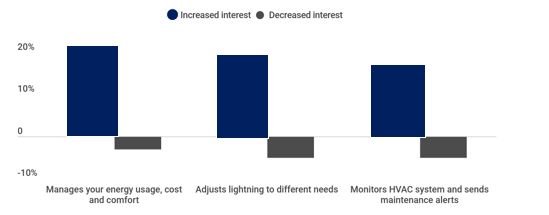Curbing the Energy Crunch
13 June 2022
Share with a Friend
All fields required where indicated (*)Energy management is already a key component of the smart home and the current crisis is encouraging more people to explore options for cutting energy consumption (see graph). By favoring cleaner energy, providing insights into energy usage, and reducing energy consumption, smart home solutions can help to cut energy bills and emissions. Moreover, these energy solutions will lay a basis for further smart home adoption. Once people trust their homes to manage their energy, they are likely to let it look after other areas too.
Consumer Interest in Energy Solutions Continues to Grow

Source: Parks Associates, data from September 2020 until October 2021.
Laying out a smart home energy infrastructure
Our homes can help significantly in reducing our energy consumption. A first step is to introduce the right infrastructure by replacing electric heating systems and water heaters with air source heat pumps and heat pump water heaters. Other quick wins are the addition of insulation, energy efficient lighting and even smart window solutions. The latter control incoming light and change appearance based on the amount of sunlight, heat, cold and more.
Smart meters and thermostats are a core part of the smart energy installation. They provide residents with insights into energy consumption, enabling them to act in ways that save energy and lower the electricity bill. Parks Associates research even found that smart thermostat owners in the US saved $49 per month on average as a result of these devices.
The home as a power plant
In addition to saving energy, our homes can also generate electricity. A growing number have solar panels to supplement their electricity needs and even sell their energy back to the grid. Unfortunately, the growth of solar in several regions is hampered by limitations in the electricity network. Nevertheless, power companies are working hard to upgrade their networks for solar power backed by home batteries and even electric cars; residents will be able to store their excess production.
Tesla, for instance, is hoping to turn some Texas homes into “virtual power plants” after tests showed its home batteries can be quickly tapped to reduce stress on the state grid. Moreover, smart meters can also take the energy availability into account. Google’s Nest, for example, allows homes to automatically adjust their heating and cooling to favor cleaner energy.
Catalyst for smart home adoption
Whereas many smart home solutions – as described in a previous blog – might be characterized as gadgets, smart energy solutions can truly solve a consumer problem. Moreover, once people have installed a smart energy system, it is a small step to add other smart home functionalities, such as a security system, setting the stage for further adoption and the development of new services described in our earlier blogs.
Informations importantes
À des fins d’information et de publicité uniquement.
Ces informations proviennent de VanEck (Europe) GmbH qui a été désignée comme distributeur des produits VanEck en Europe par la société de gestion VanEck Asset Management B.V., de droit néerlandais et enregistrée auprès de l’Autorité néerlandaise des marchés financiers (AFM). VanEck (Europe) GmbH, dont le siège social est situé Kreuznacher Str. 30, 60486 Francfort, Allemagne, est un prestataire de services financiers réglementé par l’Autorité fédérale de surveillance financière en Allemagne (BaFin). Les informations sont uniquement destinées à fournir des informations générales et préliminaires aux investisseurs et ne doivent pas être interprétées comme des conseils d’investissement, juridiques ou fiscaux. VanEck (Europe) GmbH et ses sociétés associées et affiliées (ensemble « VanEck ») n’assument aucune responsabilité en ce qui concerne toute décision d’investissement, de cession ou de rétention prise par l’investisseur sur la base de ces informations. Les points de vue et opinions exprimés sont ceux du ou des auteurs, mais pas nécessairement ceux de VanEck. Les avis sont à jour à la date de publication et sont susceptibles d’être modifiés en fonction des conditions du marché. Certains énoncés contenus dans les présentes peuvent constituer des projections, des prévisions et d’autres énoncés prospectifs qui ne reflètent pas les résultats réels. Les informations fournies par des sources tierces sont considérées comme fiables et n’ont pas été vérifiées de manière indépendante pour leur exactitude ou leur exhaustivité et ne peuvent être garanties. Tous les indices mentionnés sont des mesures des secteurs et des performances du marché commun. Il n’est pas possible d’investir directement dans un indice.
Toutes les informations sur le rendement sont historiques et ne garantissent pas les résultats futurs. L’investissement est soumis à des risques, y compris la perte possible du capital. Vous devez lire le Prospectus et le DICI avant d’investir.
Aucune partie de ce matériel ne peut être reproduite sous quelque forme que ce soit, ou mentionnée dans toute autre publication, sans l’autorisation écrite expresse de VanEck.
© VanEck (Europe) GmbH
Inscrivez-vous maintenant à notre newsletter
Related Insights
Related Insights
15 mai 2024
12 mars 2024
05 juin 2024
15 mai 2024
10 avril 2024
12 mars 2024
09 février 2024
